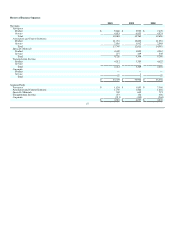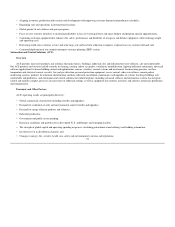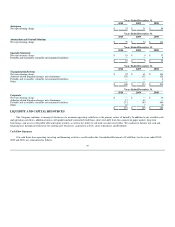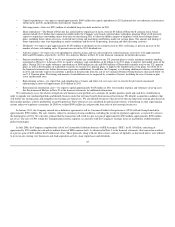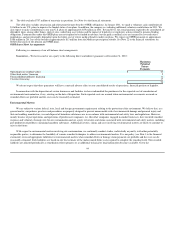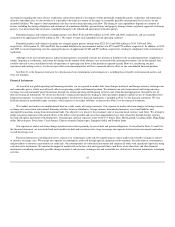Honeywell 2010 Annual Report Download - page 39
Download and view the complete annual report
Please find page 39 of the 2010 Honeywell annual report below. You can navigate through the pages in the report by either clicking on the pages listed below, or by using the keyword search tool below to find specific information within the annual report.
Specialty Materials segment profit decreased by 16 percent in 2009 compared with 2008. This decrease is principally due to lower sales as a result of
the factors discussed above, partially offset by lower material costs, reduced labor costs (reflecting reduced census, work schedule reductions and lower
incentive compensation), the positive impact of indirect cost savings initiatives and increased prices. In the fourth quarter of 2009 these factors more than
offset the impact of lower sales described above resulting in a 56 percent increase in segment profit.
2011 Areas of Focus
Specialty Materials primary areas of focus for 2011 include:
• Continuing to develop new processes, products and technologies that address energy efficiency, the environment and security, as well as position
the portfolio for higher value;
• Commercializing new products and technologies in the petrochemical, gas processing and refining industries and renewable energy sector;
• Driving sales and marketing excellence and expand local presence in fast growing emerging markets;
• Execution of awarded government projects;
• Managing exposure to raw material commodity fluctuations; and
• Investing to increase plant reliability and operational effectiveness, productivity, quality and operational excellence.
Transportation Systems
Overview
Transportation Systems provides automotive products that improve the performance, efficiency, and appearance of cars, trucks, and other vehicles
through state-of-the-art technologies, world class brands and global solutions to customers' needs. Transportation Systems' products include turbochargers and
charge-air and thermal systems; car care products including anti-freeze (Prestone(R)), filters (Fram(R)), spark plugs (Autolite(R)), and cleaners, waxes and
additives (Holts(R)); and brake hard parts and other friction materials (Bendix(R) and Jurid(R)). Transportation Systems sells its products to original
equipment ("OE") automotive and truck manufacturers (e.g., BMW, Caterpillar, Daimler, Renault, Ford, and Volkswagen), wholesalers and distributors and
through the retail aftermarket.
Economic and Other Factors
Transportation Systems operating results are principally driven by:
• Financial strength and stability of automotive OE manufacturers;
• Global demand for automobile and truck production;
• Turbo penetration rates for new engine platforms;
• Global consumer preferences for boosted diesel passenger cars;
• Degree of volatility in raw material prices, including nickel and steel;
• New automobile production rates and the impact of customer inventory levels on demand for our products;
• Regulations mandating lower emissions and improved fuel economy;
• Consumers' ability to obtain financing for new vehicle purchases; and
• Automotive aftermarket trends such as consumer confidence, miles driven, and consumer preference for branded vs. private label aftermarket and
car care products.
36



